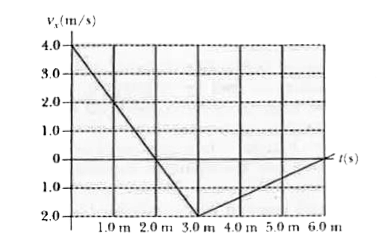A particle moves along the curve y2=2x where x=t22 & y>0. What is the acceleration of the particle at t=2s ?
ˆi
ˆj
ˆi−ˆj
2ˆi
The correct Answer is:A
x=t22
vx=2t2⇒ax=ˆi
y2=2×t22
⇒y=t⇒ay=0
→a=→ax+→ay=ˆi
Topper's Solved these Questions
- BOOK - BANSALCHAPTER - TEST PAPERSEXERCISE - PHYSICS PART (A)32videos
TEST PAPERS
- BOOK - BANSALCHAPTER - TEST PAPERSEXERCISE - PHYSICS PART (B)3videos
TEST PAPERS
- BOOK - BANSALCHAPTER - TEST PAPERSEXERCISE - PHYSICS PART- C4videos
TEST PAPERS
- BOOK - BANSALCHAPTER - SEMICONDUCTORSEXERCISE - CBSE Question32videos
SEMICONDUCTORS
Similar Questions
A particle moves along the curve y=x2+2x. At what point(s) on the curve are the x and y coordinates of the particle changing at the same rate?
View SolutionVelocity (in m/s) of a particle moving along x-axis varies with time as, v=(10+5t−t2) At time t=0,x=0. Find
(a) acceleration of particle at t=2s and
(b) x-coordinate of particle at t=3sView Solution
Knowledge Check
- Question 1 - Select One
vx is the velocity of a particle moving along the x-axis as shown in the figure. If x=2.0m at t=1.0s, what is the position of the particle at t=6.0s ?
 A−2.0 mB+2.0 mC+1.0 mD−1.0 m
A−2.0 mB+2.0 mC+1.0 mD−1.0 m - Question 2 - Select One
A particle moves along the positive branch of the curve y=x22 where x=t22,x and y are measured in metres and t in second. At t=2s, the velocity of the particle is
A2ˆi−4ˆjms−1B4ˆi+2ˆjms−1C2ˆi+4ˆjms−1D4ˆi−2ˆjms−1 - Question 3 - Select One
A particle moves a distance x in time t according to equation x2=1+t2 . The acceleration of the particle is
A1x3B1x−1x2C−tx2D1x−t2x3
If the velocity of a particle moving along x-axis is given as v=(3t2−2t) and t=0, x=0 then calculate position of the particle at t=2sec.
View SolutionThe x and y coordinates of a particle at any time t are given by x=7t+4t2 and y=5t, where x and t is seconds. The acceleration of particle at t=5s is
View SolutionA particle moves along the X-axis as x=u(t−2s)=at(t−2)2.
View SolutionThe equation of a particle moving along a straight line is s=2t3–9t2+12t, where the units of s and t are cm and s. the acceleration of the particle will be zero after
View SolutionThe displacement 'x' of a particle moving along a straight line at time t is given by x=a0+a1t+a2t2. The acceleration of the particle is :-
View Solution

